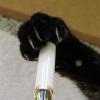Search the Community
Showing results for tags 'chinkin'.
-
The Chinkin process sounds rather simple but there is no room for error in carving the surface material. An appropriate design for the lacquered object is initially sketched. Then the artist ‘carves’ the urushi surface with special chisels and carving tools. Next, urushi is rubbed just into the lines and dots as adhesion and sprinkled with gold foils, powders, or colored pigments, and finally polished by washi, a japanese traditional paper. The Sailor Chinkin Bumbeblee limited edition is created by Chinkin artist Misato Tsukada. Only 28 pcs for the world. If you are interested #3/28 can be yours. https://www.sakurafountainpengallery.com/en
-
- sailor
- sailorbumblebee
- (and 3 more)
-
Shooting the Sailor Bespoke KOP Chinkin Owl for Dromgoole’s inspired me to pull out my Namiki Emperor Chinkin Dragon and run it through the focus stacked macro ringer. I’d say it availed itself. F8B88398-F81A-4B6A-A5F5-C981F315526F by Ja Ja, on Flickr EE178EB1-23E4-4056-B7BB-80B3EDD2E062 by Ja Ja, on Flickr
-

Wise old Sailor Bespoke KOP Chikin Owl--incredible pen and more incredible box
jandrese posted a topic in Japan - Asia
I shot this for Dromgooles. Gorgeous chinkin work on the pen but the box is superlative. Expensive but worth every penny. uncapped pen at rest yes logo by Ja Ja, on Flickr Owl pen closeup yes logo by Ja Ja, on Flickr Full capped yes logo 1st choice by Ja Ja, on Flickr box owl yes logo by Ja Ja, on Flickr box yes logo by Ja Ja, on Flickr- 6 replies
-
- sailor
- sailor bespoke
-
(and 3 more)
Tagged with:
-
Wanted to present my current stable of Stylo Art pens. 1. Akebono/bokashi chinkin butterflies 2. Dragon maki-e 3. Pine tree and cranes maki-e The pen bodies are exclusive to Stylo Art and are large pens being slightly bigger than a Namiki Yukari but are lightweight. I believe the base material is plastic. The akebono chinkin pen has an amazing Pilot #15 nib custom ground by Yukio Nagahara to what is called an N-point. It writes a super smooth and juicy fat line at about 45 degree that gets more narrow as the pen angle is steepened. It's kinda a cross between a Sailor Zoom and Naginata grind sort of, it's doing it's own thing really. The other two pens have stock (?) Pilot stub nibs, which be warned, are really more like cursive italics. Wonderful nibs but a little more demanding than a Western stub. All come with Paulowina wood boxes, pen sleeves, and CON-70 converters. Most excellent pens and more than fairly priced. Highly recommended. capped rotated_SON3728 by Ja Ja, on Flickr capped fan_SON3729 by Ja Ja, on Flickr uncapped_SON3731 by Ja Ja, on Flickr writing sampe by Ja Ja, on Flickr
-
Remember when Travolta opened the briefcase in Pulp Fiction? Now I know what was inside! As is my preference I ordered this Nakaya directly from Japan via email. They are always most pleasant and the nib adjustment beyond reproach. I’ve collected fountain pens for nearly 25 years and this is far from my first urushi fountain pen. It’s not even my first chinkin pen. Nevertheless, I am astonished by this amazing pen. The combination of beauty, bespoke craftsmanship, and writing qualities are unmatched in my collection. The finish is darker, more subdued, radiant, gorgeous, brighter, and bewitching than I imagined. Confused? It depends on the ambient light, but this pen quietly screams sublimity. The size, shape, balance, geometry, design, and execution render a pen that simply functions as a superb writing instrument. The medium nib writes what appears to be a boringly unwavering (Japanese) medium line. What you cannot observe is the experience that is one of supreme confidence and superlative feel. It puts down exactly the amount of ink required smoothly without fuss at the exact angle I hold the pen. It’s…natural. The packaging is standard Nakaya and the one “upgrade” I got was the urushi koi painted converter, which is very cute. The pen shipped with a cartridge in place all ready to write; a bit of a surprise but a pretty confident move. This pen was made for writing. A hand-made piece of high-end art with a purpose. Here it is compared to the Sailor KOP vermilion urushi. The KOP costs almost double...
-
The Hawk is a fascinating bird of prey. In many cultures around the world, the hawk is admired for its courage, power and determination. In addition to being fearless, intrepid and daring, the hawk is patient and strong. And with its all-seeing eye, the Hawk seeks out its prey with deadly efficiency. The Sailor Limited Edition “Hawk” was created for a private membership in the Far East. Twenty items have been made for Oriental collectors, while only five are available for the rest of the world. The artists proof can be visited in our Boutique until April 22nd. This Chinkin Hawk is a master piece ! http://www.sakurafountainpengallery.com/en/fpngallery/gallery-detail/hawk-sailor-limited-edition
-
Chinkin is a technique where a special set of very fine chisels are used to carve a pattern or design into layers or urushi (lacquer). The indentations are then rubbed with sticky urushi and gold powder or foils are placed over it to fill in the marks made by the chisels. Sometimes colored urushi powders might be used instead of gold. Once they are applied the pen is often cleaned by a Japanese paper called washi. Traditionally much of this art originated in Waijima starting around the 13th century, but today it is produced in many Japanese prefectures and even other countries like China. As this is a carving technique at its heart, there is little room for error so quality work often takes many focused hours to complete. Doing some research, I came across the Danitrio website that lists 5 chinkin techniques: 1. Ten-bori (carving by point): The size of points could be as small as only 0.1mm, and it is the only way to make the surface for the design by chiseling points one by one. 2. Ten-bori no Bokashi (Gradation of point carving): Reducing the chisel points and changing the space between the points to make the design with gradation. 3. Ten-bori no Henka (Variation of point carving): To push (Tsuki-nomi) or draw (Hiki-nomi) the chisel from a point to carve various short lines in a small space. 4. Suji-bori (Line carving): Short or long, straight or curved lines can be carved by skillful craftsmen. 5. Katagiri-bori (Carving sharp curved or angle lines): Use a special chisel to carve strong contrasting lines. I find any of these techniques can yield some very stunning results. I would like for anyone with pens decorated with the chinkin to post some photos in this thread and share any thoughts on the art form – whether you like it or not. If you can add more nuances to the history of the art, please do so and we can make this thread into a learning opportunity.






